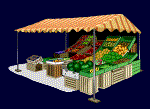The Project Renaissance
Approach to Public-Private Enterprising
Distribution: Internet, Press
Version: 1.05
Originally Posted: 04 June, 1997
Last Modified: 08 June, 1997
Author: Kirby Urner
Company: 4D Solutions
Outline
- What is Project Renaissance?
- Who Participates?
- What are the Projected Outcomes?
What is Project Renaissance?
Project Renaissance is an approach for integrating public and private enterprising into a unified model or rubric. The concepts are in the public domain and no trademark or copyright ownership of the central Project Renaissance name or literature is expressed or implied.
The Project Renaissance approach seeks to converge the not-for-profit sector with the R&D operations of high technology enterprises, which have likewise historically received generous treatment from the government, especially in times of war – hot or cold.
The USA Johnson Era War on Poverty programs, these days branded a failure which even liberals have a hard time defending, at least captured the ‘moral equivalent of war’ rhetoric, but did little at the bookkeeping level to motivate the transition to a peace-time economy characterized by opportunities for advancement at all socioeconomic levels.
Indeed the Vietnam War was in full swing at the time and prime contractor relationships between Washington DC and high tech R&D divisions, via such Manhattan Project legacy institutions as the national labs (e.g. Los Alamos), think tanks such as the RAND corporation, and the Massachusetts Institute of Technology (MIT), left little room in the budget, or on the drafting tables of USA engineering studios, for a Project Renaissance approach. So what has changed? The American people, promised a Peace Dividend at the conclusion of the more overt phases of the Cold War, have yet to relinquish their historical fascination with positive future scenarios, as typified by Walt Disney’s groundbreaking creation of his Experimental Prototype Community of Tomorrow (EPCOT), wherein brand name corporations would showcase prototypes, working models, drawing board solutions, and garner public feedback – a combination of market research and willing guinea pigging, in this case providing all the safeguards expected of Disney-quality family entertainment theme parks.

Given this latent optimism about the future, always just beneath a more cynical surface, cogent story boarding showing how the Peace Dividend may indeed be deployed in a real time context, without loss of security or exposure to unacceptable levels of terrorist threat, immediately attracts a receptive audience. Enter Project Renaissance.
Project Renaissance converges Hollywood experience in scripting and casting with military experience in contracting for and testing prototypes, and focuses the synergies thereby derived within the noncommercial, public service sector, with an eye towards field testing new solutions at the ‘front lines’, in a real time ‘school of hard knocks’, the outcomes of which will be, in many cases if not most, commercializable goods and services, ready for vending to the public at large.
The public, in the meantime, will already have some clear ideas about how the new products and services are used, having tuned in lots of media ‘from the front’ showing the prototype versions in action, often in demanding situations (more demanding than the average civilian is likely to encounter, unless volunteering for duty in public service, or unlucky, as when involuntarily subjected to severe weather or other harsh environmental conditions).
Who Participates?
Prototyping work may be exciting, sexy, and attractive to people who wish to excel and gain recognition for their competency and skills. Test pilots generally fall into this category, as do astronauts, technology jocks (both female and male) and other forms of dare devil. However, given the often times significant investments riding on the success of a prototyping venture, set-backs owing to over confidant or cavalier behavior or foolish misjudgments of the true risks involved need to be minimized.
So between the gung-ho would-be star performers in Project Renaissance scenarios, and their dream jobs (or roles – Disney referred to his human resources division as the ‘casting’ department), one or more layers of ‘gatekeeper’ intervene, trainers and recruiters of various stripes charged with ensuring that trainees advancing through their ‘gates’ have attained an appropriate level of mastery.
Such screening never completely precludes the possibility of disaster, nor of people ‘slipping through’ on the basis of fraudulence or other leaks in the gating system. Furthermore, highly trained professionals with all the necessary skills and credentials may nevertheless find themselves participating in a no-win situation, either because the prototype is in some way fundamentally flawed, or owing to freakish circumstances beyond the control of participants. The goal of the gating system is to establish the conditions necessary for optimized field testing, and not to assure in advance that all field tests or missions will succeed (in which case they would not really be tests).
For example, remotely deployed Fly’s Eyes, hard-shell dwelling units, optionally tripod-based and outfitted with telecommunications and sensing equipment, take skill to operate, especially in harsh environments such as close to the poles or in ecosystems with little use for humans. Trainees operating these units must know what to do when critical systems fail, when to call for emergency evacuation as a last resort and so on. Trainees must also know how to follow ‘zero-impact’ guidelines when this protocol is in effect, meaning the team will leave approximately no trace of its presence once the mission (perhaps a survey mission) is complete.

Beyond certification on various technologies, however, trainees will in many instances be called upon to evidence high level ‘people skills’. The public service community, via UNESCO, UNHCR, CARE, the Red Cross, and other well known NGO operations, has historically been charged with all kinds of disaster relief, rescue, evacuation and medical response missions.
These operations typically require line of supply logistics, command and control, communications, crowd management, triage, rapid deployment, rapid pull-out and so on. Of course NATO provides similar services, with greater emphasis on weaponry, but the central point is the same: trainees may be called upon to exhibit extremely high levels of proficiency in languages, diplomacy and negotiating skills, often under time pressure, with grave consequences attending any delays.
Project Renaissance works to minimize the size and intensity of such ‘crisis’ situations however, as the human design has its limits and will fail under extreme conditions, as will any special case design. Putting humans in intractable and superhumanly difficult situations is generally to be avoided except perhaps in certain simulated situations.
Thinking, planning and storyboarding provide an antidote to a purely ’emergence by emergency’ approach of lurching from one crisis to the next, wherein humans predictably suffer a decreased ability to coordinate, or even freeze into a panic-stricken, immobilized mode, neither of which conditions helps us get a grip on the situation.
Uncoordinated or inappropriate responses, including violently damaging ones, are symptomatic of humans pushed beyond the limits of their present capabilities and is often a manifestation of having done too little too late in anticipation of contingencies that might have been planned around or otherwise prepared for, had the relevant situation rooms worked harder to keep abreast of real time developments around the world and in its surrounding space.
Project Renaissance aims at providing plenty of historical, computer simulated, extrapolated and real time global data, so that humans may provide themselves with the most relevant kinds of preparation and training. Project Renaissance also looks to what R. Buckminster Fuller termed “comprehensive anticipatory design science” for clues as to what might be in store in upcoming chapters of the humans in Universe story, which has already proved to be something of a cliff-hanger (or ‘touch and go’ as Fuller would put it).
All of the foregoing analysis, starting with a focus on willing recruits anxious for front lines experience, moving through systems of gate keepers or trainers based around the need for a huge variety of skill sets among trainees, and concluding with a commitment to assist people in staying well-versed in big picture planning, via access to timely global data, is but the tip of the iceberg, a quick overview of the Project Renaissance context. A more detailed treatment of public-private enterprise management is taken up in General Systems Theory (GST) in the form of curriculum coursework and hands-on work-study engagements. Access to Project Renaissance top management positions requires a high level of mastery of GST concepts and their application in real time.
What are the Projected Outcomes?
Project Renaissance is about converging civilian and military disciplines into a more unified set of public services which tackle difficult problems faced by humans, families and communities both locally and overseas. The Peace Corps (with analogous services in other countries, e.g. WUSC, UNV…) provides a lot of useful templates for how these services will look, but with the added dimension of higher levels of technology (designed for appropriate use), more characteristic of the military.

For example, there’s no reason why aircraft or helicopter carriers can’t be used as valuable assets in support of ground-based emergency relief or evacuation efforts (indeed, USA aircraft carriers have been involved in just such evacuation missions recently, off the coast of West Africa for example). Some of the personnel operating these assets may have trained in NATO — others may have a background with Greenpeace. Despite past political differences, both the military and the NGO sector have produced personnel with complementary and compatible training.
The expected outcome is a growing inventory of ‘props’ available for use within storyboarded ‘theater’, as per General Systems Theory’s model of the Projects Completion Cycle. Many of these inventory items will have been brainstormed and prototyped in the field by private firms, with an eye towards commercializing the perfected models and offering them for sale or via leasing agreements through networks of value-adding resellers (VARS) or direct outlets.
Whereas commercial advertising will remain in the picture, a lot of the best PR will have come into viewer living rooms from the front line operations theaters, or from lower profile situation room scenes — often shown in real time ala Houston’s Mission Control or NORAD, not just as Hollywood-style mock ups. Although mock ups are often more impressive than their real world counterparts, they fail an important relevance test when showcasing technologies we have no idea how to actually implement in real time, as in the Star Trek scenarios, which feature a ‘Federation Science’ only hypothetically available to humanity in the 24th century (western calendar).
Project Renaissance style ‘science fiction’, by contrast, is both ‘near future’ and centered around existing, accessible, operational props and prototypes. Project Renaissance storyboards are critically dependent only on currently attained levels of comprehension of scientific principles. Not every storyboard launched in the public domain for testing and feedback should or will be implemented, at least on the scale originally planned, but at least the degree of realism will remain high, so that the general public will not be overly confused as to their options, which confusion too often leads to voting taxpayers pinning lots of hope on scenarios that scientists and engineers simply cannot make real, hence wasting valuable time and investments and resulting in widespread cynicism and dissillusionment with the political process.

According to this Project Renaissance storyboard, we anticipate that the general public will not generally begrudge the tax-exempt status given the public service sector, nor the tax-breaks afforded corporate R&D departments, given ample media unambiguously documenting the positive impact of Project Renaissance type programming. The commercial sector will not complain (or at least not too loudly) that their operations are adversely affected by all this focus on noncommercial programming because so many of the goods and services it markets will have derived from public sector risk-taking. Furthermore, commercial enterprises will be actively engaged in exchanging information and personnel within this public sector context, finding the positive synergies discovered in field testing are a constant source of new ideas for commercial operations and collaborative ventures.
Finally, the viewing public, which includes people from all walks of life, will in many cases feel drawn to get involved, to do more than passively experience all the action via one-way television. Two-way, interactive circuits within the living room or home office context, giving viewers ways to track favorite teams (sometimes including friends and acquaintances), will likewise supply a variety of channels for providing teams with backing, both directly and indirectly, monetarily and otherwise. These ‘distance education’ circuits are already in place, and are becoming more sophisticated and prevalent with each passing day. Schools are coming on-line and will also have many opportunities to mix classroom experience with community service opportunities, with some of the action on screen suggesting role models worth emulating, despite the long years of training that may sometimes be required before joining an all-star cast.
In sum, media programming designed to provide sustainably higher living standards on a global basis is inherently interesting, and the products and services stemming from this programming, perhaps soon to appear via local outlets and distributorships, will require lots of time, energy and human ingenuity to perfect in the field, and to variously integrate into our increasingly complex econosphere, characterized by many differently organized and differently performing cultures — more all the time as communities experiment with new ways of integrating various traditions, sometimes producing attractive and viable results (of course folks will always disagree when it comes to matters of taste).
Project Renaissance, with the emerging disciplines of General Systems Theory and Design Science to back it up (among others), is a logical extrapolation of many trends and already tested models. It provides a way to maintain continuity and professionalism for those trained in a military context, while bringing high technology corporate R&D divisions under a new umbrella, to be shared with public sector operations, including religiously minded ones, not as ‘mere charities’ good for PR and tax write-offs, but as partners in prototyping — the public service arena being ‘where the action is’ when it comes to getting our next century (western calendar) off to a promising beginning.


 General systems theory begins with Earth as the microeconomic client of an energy-grant source, the Sun. Given that solar energy grants are not interest-bearing notes, the client economy is off the hook as far as submitting a repayments schedule, is really more akin to a not-for-profit in receipt of grant monies than a third world borrower against World Bank accounts. By extension, the subcircuitry within the Earthian ‘motherboard’ derives from this initial macrocosmic relationship. This is not a new model. Ancient Egyptian and Mayan civilizations came up with something similar. But every age needs to find its own characteristic narrative accounting language most relevant to the challenges at hand.
General systems theory begins with Earth as the microeconomic client of an energy-grant source, the Sun. Given that solar energy grants are not interest-bearing notes, the client economy is off the hook as far as submitting a repayments schedule, is really more akin to a not-for-profit in receipt of grant monies than a third world borrower against World Bank accounts. By extension, the subcircuitry within the Earthian ‘motherboard’ derives from this initial macrocosmic relationship. This is not a new model. Ancient Egyptian and Mayan civilizations came up with something similar. But every age needs to find its own characteristic narrative accounting language most relevant to the challenges at hand. By imputing a
By imputing a  Obviously GST is mirroring the movie-business in this picture of the individual enterprise, but is expanding the metaphor to carry the ‘dollars and sense’ values of film production into the larger economy, where lifestyles, both ‘at home’ and ‘at work’ are theatrical productions minus some of the camera work (some jobs in politics, having cameras everywhere, are now practically indistinguishable from TV and movie-making).
Obviously GST is mirroring the movie-business in this picture of the individual enterprise, but is expanding the metaphor to carry the ‘dollars and sense’ values of film production into the larger economy, where lifestyles, both ‘at home’ and ‘at work’ are theatrical productions minus some of the camera work (some jobs in politics, having cameras everywhere, are now practically indistinguishable from TV and movie-making). ‘Storyboarding’ stands for generic planning and the ‘Java thermometer applet’ stands for the generic need to attract investments. But of course real world investors are usually risking monetary account equity with an eye toward reaping rewards in kind, and so commit to transactions involving commercial paper with cash infusion promises attached (or at least the paper itself has to have trade value, even if a redemption date is set for some years hence). In other words, website scenarios attract funding in proportion to their ability to deliver those currency units most relevant to investors, who usually carry debt themselves and need to discharge back to their creditors, and so on.
‘Storyboarding’ stands for generic planning and the ‘Java thermometer applet’ stands for the generic need to attract investments. But of course real world investors are usually risking monetary account equity with an eye toward reaping rewards in kind, and so commit to transactions involving commercial paper with cash infusion promises attached (or at least the paper itself has to have trade value, even if a redemption date is set for some years hence). In other words, website scenarios attract funding in proportion to their ability to deliver those currency units most relevant to investors, who usually carry debt themselves and need to discharge back to their creditors, and so on. Of course some props are not ‘for sale’ as usable-in-scenarios in any simple ‘price tag’ sense. This is true, for example, where you need to pass certain competence tests before being allowed to do surgery, fly an airplane, pilot an oil tanker or whatever. There’s no substitute for learning the job, no way that currency units will short circuit around this requirement, because the phoniness of the ensuing performance will be obvious to all (or at least to those trained to detect fakes, e.g. the examiners).
Of course some props are not ‘for sale’ as usable-in-scenarios in any simple ‘price tag’ sense. This is true, for example, where you need to pass certain competence tests before being allowed to do surgery, fly an airplane, pilot an oil tanker or whatever. There’s no substitute for learning the job, no way that currency units will short circuit around this requirement, because the phoniness of the ensuing performance will be obvious to all (or at least to those trained to detect fakes, e.g. the examiners). Some ID-linked credits towards accessing some of the props and scenarios will be dispensed in exchange for performance, and will not be sellable for cash in exchange, i.e. your competence to do brain surgery is not something you can turn around and sell for cash to someone with no training, although you can ‘bank on it’ in other senses (e.g. become a teacher of your skill if you can find others willing to invest (of course some ‘dying arts’ don’t attract many earnest learners, which can mean the art is of fading relevance, or maybe the surrounding curriculum context is bogus (lack of learners doesn’t ipso facto mean the discipline is worthless, contrary to what a ‘free market’ analysis might conclude))).
Some ID-linked credits towards accessing some of the props and scenarios will be dispensed in exchange for performance, and will not be sellable for cash in exchange, i.e. your competence to do brain surgery is not something you can turn around and sell for cash to someone with no training, although you can ‘bank on it’ in other senses (e.g. become a teacher of your skill if you can find others willing to invest (of course some ‘dying arts’ don’t attract many earnest learners, which can mean the art is of fading relevance, or maybe the surrounding curriculum context is bogus (lack of learners doesn’t ipso facto mean the discipline is worthless, contrary to what a ‘free market’ analysis might conclude))).








